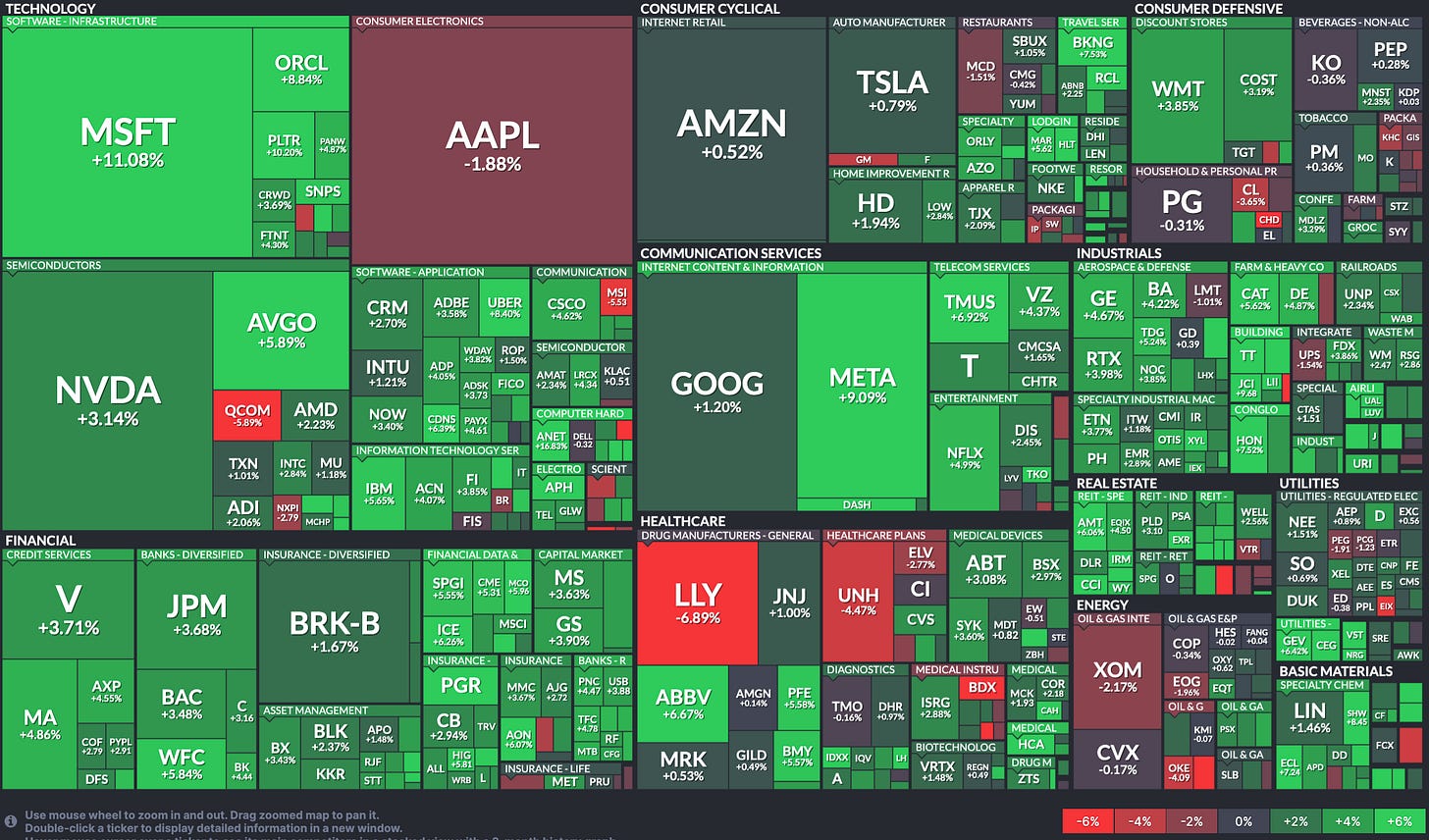After a scorching 7% rally in just four trading days the previous week to almost pre-”Liberation Day” levels, stocks took a breather at the open on Monday as a jam-packed week of earnings reports and economic data got under way.
The indexes spent most of the day heading slowly but steadily lower as institutional traders took some chips off the table, particularly in the tech arena, after the previous week’s run-up in prices and ahead of the imminent earnings reports from four of the Magnificent Seven companies. But a late surge, mostly driven by hopeful retail dip-buying ahead of those earnings reports, pushed the indexes slightly into positive territory by the close.
Mark Carney was narrowly confirmed on Tuesday morning as Prime Minister in the Canadian election, effectively handed victory as a crisis manager by Trump’s threats and 51st state babble. Stocks meandered aimlessly between gains and losses in a narrow range for most of the session before another late rally produced a sixth straight day of gains for the S&P 500, the longest winning streak of the year.
By the time Wall Street opened for business on Wednesday, we had seen the latest Gross Domestic Product (GDP) estimate for Q1, which came in worse than expected with a 0.3% quarter-on-quarter decline, the first time for three years that the US economy has lost forward momentum.
It was also confirmed at the same time that inflation is coming back to life and that does not bode well for Fed interest rate cuts. The Personal Consumption Expenditures (PCE) Price Index measure of inflation (the measure that the Fed really cares about) soared to a 3.6% annual rate in Q1 2025 from 2.4% the previous quarter.
After an initial move sharply lower on the back of this highly stagflationary combo, stocks reversed course as traders re-examined the fine print of the both data sets and found some nuggets of hope in the more sliced-and-diced core numbers, including what may be a temporary massive spike in specific imports. The S&P 500 just about managed to squeak out a seventh consecutive day of gains.
Stock indexes closed out a highly volatile month of April very close to where they had started it, but with a 10% drop in the S&P 500 and retracement in between, the largest such intra-month fall and recovery since 1950.
Microsoft and Meta/Facebook both reported their respective first quarters after the close and Wall Street liked what it saw. Their earnings and revenue topped forecasts and each reported continued high levels of capital spending.
Enthusiasm around the previous evening’s earnings reports from two of the index heavyweights helped push prices higher on Thursday morning and the momentum was maintained through the close (particularly in the tech and tech-adjacent sectors) and day eight of the S&P 500’s winning streak was comfortably in the books.
Two more Magnificent Seven companies reported after the bell but the positive vibes of the previous evening were notably absent. Apple and Amazon each reported results that matched expectations but failed to offer upbeat forecasts in the face of tariffs. Both stocks were punished in after-hours trading.
The big news overnight into Friday was that China is apparently “evaluating the possibility” of trade talks with the US. The highly-anticipated pre-market Jobs Report came out a little better than expected, with unemployment steady at 4.2%. This was viewed as a win by traders, many of whom had feared a possible nasty surprise.
Stocks jumped when the opening bell rang. More positive earnings reports, including from Exxon-Mobil, helped things along and the S&P 500 charged to its ninth consecutive day of gains, its longest winning run in more than twenty years.
Following the election, the stock market quickly laid its bets on tax cut extensions, deregulation and tariffs - but in that order. That’s not what has happened, since Trump can only unilaterally implement one of the three using legally-questionable emergency powers and executive orders and dived right into the tariffs, while the tax cuts and deregulation languish in Congress.
The result was an S&P 500 down 7% over Trump’s first 100 days (here is a cool graphic showing the breakdown of each individual stock over that time), the worst performance since Nixon in 1973, despite the fact that the index even hit an all-time record high on February 19th. Trump’s 100-day approval ratings are also the lowest of any president (including himself in 2017) since records began 80 years ago.
We were promised candy before the broccoli, but it’s being served the other way around and it’s pissing off a lot of people.
If you are not yet a client of Anglia Advisors and would like to explore becoming one, please feel free to reach out to arrange a complimentary no-obligation discovery call with me.
ARTICLE OF THE WEEK ..
“Think about portfolio changes through the lens of risk and reward - not bullish or bearish .. Risk is in the eye of the time horizon.”
Ben Carlson on the perils of investing emotionally and the “Magic Formula”.
.. AND I QUOTE ..
“The risk is not that the US falls behind overnight. Rather, it is that capital markets gradually begin to price the US like any other market.”
John Zito, Co-president of Apollo Global asset-management.
LAST WEEK BY THE NUMBERS:
Last week’s market color courtesy of finviz.com
Last week’s best performing US sector: Industrials (two biggest holdings: GE Aerospace, RTX) ⬆︎ 4.4% for the week
Last week’s worst performing US sector: Energy (two biggest holdings: Exxon-Mobil, Chevron) ⬇︎ 0.6% for the week
SPY, the S&P 500 Large Cap ETF, tracks the S&P 500 index, made up of 500 stocks from a universe of the largest U.S. companies. Its price rose 3.2% last week, is down 3.3% so far this year and ended the week 7.5% below its all-time record closing high (02/19/2025).
IWM, the Russell 2000 Small Cap ETF, tracks the Russell 2000 index, made up of the bottom two-thirds in terms of company size of a universe of 3,000 of the largest U.S. stocks. Its price rose 2.9% last week, is down 9.3% so far this year and ended the week 17.4% below its all-time record closing high (11/08/2021).
INTEREST RATES:
FED FUNDS * ⬌ 4.33% (unchanged)
PRIME RATE ** ⬌ 7.50% (unchanged)
3 MONTH TREASURY ⬆︎ 4.33% (4.32% a week ago)
2 YEAR TREASURY ⬆︎ 3.83% (3.74% a week ago)
5 YEAR TREASURY ⬆︎ 3.92% (3.88% a week ago)
10 YEAR TREASURY *** ⬆︎ 4.33% (4.29% a week ago)
20 YEAR TREASURY ⬆︎ 4.81% (4.75% a week ago)
30 YEAR TREASURY ⬆︎ 4.79% (4.74% a week ago)
Treasury data courtesy of ustreasuryyieldcurve.com as of the market close on Friday.
* Decided upon by the Federal Reserve. Used as a basis for interbank loans and for determining high yield savings rates.
** Wall Street Journal Prime rate. Used as a basis for determining many consumer loan rates such as credit cards, personal loans, home equity, securities-based lending and auto loans.
*** Used as a basis for determining mortgage rates.
AVERAGE 30-YEAR FIXED MORTGAGE RATE:
⬇︎ 6.76%
One week ago: 6.81%, one month ago: 6.64%, one year ago: 7.22%
Data courtesy of: FRED Economic Data, St. Louis Fed as of last Thursday.
FEDWATCH INTEREST RATE TOOL:
Where will the Fed Funds interest rate be after the next rate-setting meeting on May 7th?
Unchanged from now .. ⬆︎ 97% probability (91% a week ago)
0.25% lower than now .. ⬇︎ 3% probability (9% a week ago)
What is the most commonly-expected number of remaining 0.25% Fed Funds interest rate cuts in 2025?
⬇︎ 3 (down one from a week ago)
All data based on the Fed Funds interest rate (currently 4.33%). Calculated from Federal Funds futures prices as of the market close on Friday. Data courtesy of CME FedWatch Tool.
FEAR & GREED INDEX:
“Be fearful when others are greedy and be greedy when others are fearful.” Warren Buffet.
The Fear & Greed Index from CNN Business can be used as an attempt to gauge whether or not stocks are fairly priced and to determine the mood of the market. It is a compilation of seven of the most important indicators that measure different aspects of stock market behavior. They are: market momentum, stock price strength, stock price breadth, put and call option ratio, junk bond demand, market volatility and safe haven demand.
Extreme Fear readings can lead to potential opportunities as investors may have driven prices “too low” from a possibly excessive risk-off negative sentiment.
Extreme Greed readings can be associated with possibly too-frothy prices and a sense of “FOMO” with investors chasing rallies in an excessively risk-on environment . This overcrowded positioning leaves the market potentially vulnerable to a sharp downward reversal at some point.
A “sweet spot” is considered to be in the lower-to-mid “Greed” zone.
Data courtesy of CNN Business as of Friday’s market close.
WWW.ANGLIAADVISORS.COM | SIMON@ANGLIAADVISORS.COM | CALL OR TEXT: (646) 286 0290 | FOLLOW ANGLIA ADVISORS ON INSTAGRAM
This material represents a highly opinionated assessment of the financial market environment based on assumptions and prevailing information and data at a specific point in time and is always subject to change at any time. Although the content is believed to be correct at the time of publication, no warranty of its accuracy or completeness is given. It is never to be interpreted as an attempt to forecast any future events, nor does it offer any kind of guarantee of any future results, circumstances or outcomes.
The material contained herein is not necessarily complete and is also wholly insufficient to be exclusively relied upon as research or investment advice or as a sole basis for any financial decisions, including investment decisions or making any kind of consumer choices, without further consultation with Anglia Advisors or other qualified Registered Investment Advisor. The user assumes the entire risk of any decisions made or actions taken based in whole or in part on any of the information provided in this or any other Anglia Advisors published content.
Under no circumstances is any of Anglia Advisors’ content ever intended to constitute tax, legal or medical advice and should never be taken as such. Neither the information contained or any opinion expressed herein constitutes a solicitation for the purchase of any security or asset class. No client advice may be rendered by Anglia Advisors unless and until a properly-executed Client Engagement Agreement is in place.
Posts may contain links or references to third party websites or may post data or graphics from them for the convenience and interest of readers. While Anglia Advisors might have reason to believe in the quality of the content provided on these sites, the firm has no control over, and is not in any way responsible for, the accuracy of such content nor for the security or privacy protocols that external sites may or may not employ. By making use of such links, the user assumes, in its entirety, any kind of risk associated with accessing them or making use of any information provided therein.
Those associated with Anglia Advisors, including clients with managed or advised investments, may maintain positions in securities and/or asset classes mentioned in this post.
If you enjoyed this post, why not share it with someone or encourage them to subscribe themselves?
















